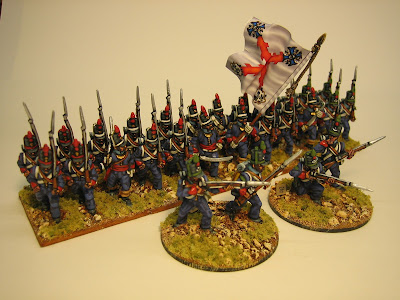Continuing with the latest additions to my mid war Spanish collection, here is a short post on two units of cazadores in the British supplied light infantry uniform (commonly referred to as 'The English Uniform') which started to arrive in Spain from January 1812. Note that some sources say similar uniforms started to arrive earlier: I have a plate (modern) of an officer of the Cazadores de Barbastro in what looks like an English Uniform dated to 1811.
Haythornthwaite says that this uniform "was like that of the line....with similar company distinctions, but entirely light blue (some sources say dark blue)". I've gone along with that for one of my units but, the plate I have for the Cazadores de Barbastro shows red collar and cuffs so I've gone with that for them: I've recently read that Spanish regimental tailors frequently altered British supplied uniforms and this may be a case in point.
The plate in Haythornthwaite's book Uniforms of the Peninsular Wars 1807 - 1814 shows a cazadore in the all light blue uniform, piped white, with white accoutrements and gaiters. I quite liked this look, especially the gaiters, so I've followed it. However, it is probably worth noting that British supplied accoutrements were sometimes black, and some light blue uniforms came with light blue gaiters.
Pictured figures are all Front Rank (straight out of the box). Flags are by Adolfo Ramos.
Note: Flags for most units are best guess / as close as I could find. If I get picked up on the wrong use of a flag I'll only sigh and shrug my shoulders (because of the limited number of flags commercially available).
The Voluntarios de Leon.
The only uniform information I have for this particular unit is dated to 1808 and by 1812 that uniform would have worn out. The Spanish expected uniforms to last three years so this unit may have been resupplied with the English Uniform: With no better information to go on, this is the name I have given to this particular unit.
Note: Information on mid war Spanish units can be sketchy. Where I have been able, I have done 'pucker' units in the correct uniforms (as far as I can paint and convert them). However, there have been plenty of guesses and fudges. Where these guesses and fudges have been made, be assured, I will tell you what they are. I'm also open to any new information you might have - please, put it in the comments for everyone to share.
Same unit, different angle.
My cazadore units will have three stands of skirmishers each. This is the same as for my French light infantry units, but the Spanish will get a down 1 modifier in the combat tables.
Cazadores de Barbastro. Basically a re-run of the above, but with red collar and cuffs.
Same unit, different angle.
I do like the white gaiters with this light blue uniform.
Next up, two battalions of the Regimiento de Toledo (which required the conversion of nearly 50 figures).























































